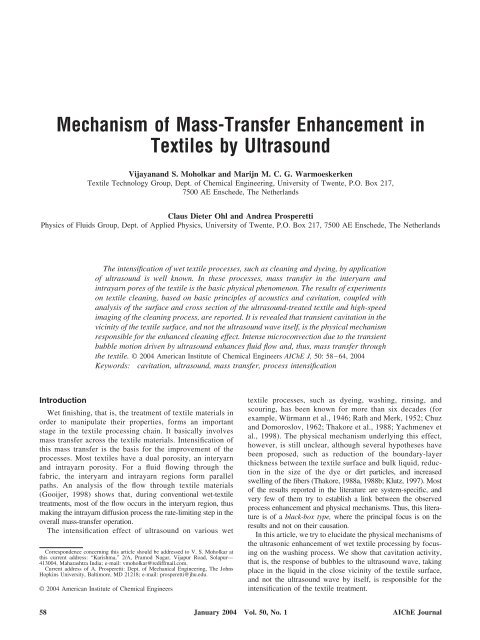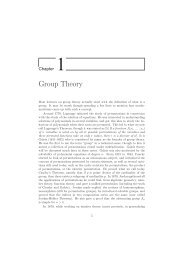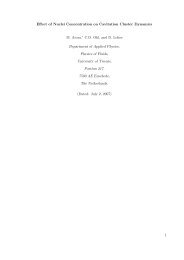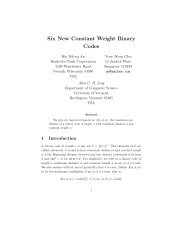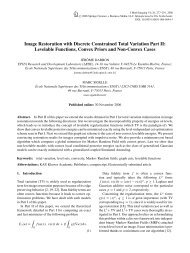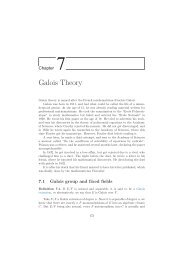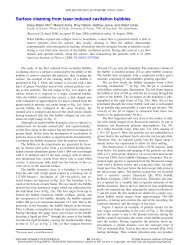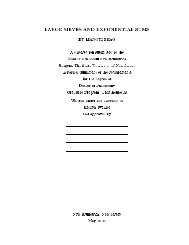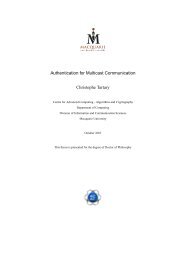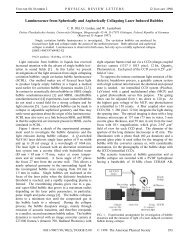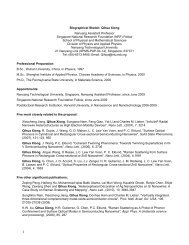Mechanism of mass-transfer enhancement in textiles by ultrasound
Mechanism of mass-transfer enhancement in textiles by ultrasound
Mechanism of mass-transfer enhancement in textiles by ultrasound
You also want an ePaper? Increase the reach of your titles
YUMPU automatically turns print PDFs into web optimized ePapers that Google loves.
mounted on a thick sta<strong>in</strong>less steel bottom, act<strong>in</strong>g as a rigidreflector for the ultrasonic waves, with four vertical bars support<strong>in</strong>gthe glass r<strong>in</strong>gs placed above each other. The <strong>textiles</strong>ample could be placed <strong>in</strong> between the glass r<strong>in</strong>gs at differentdistances from the bottom, and the glass r<strong>in</strong>gs could be pressedtogether with the lid on top <strong>of</strong> the third r<strong>in</strong>g. Rubber gasketswere placed between the textile and the glass r<strong>in</strong>gs <strong>in</strong> order toavoid leakage. Pressure amplitude at the pressure node andant<strong>in</strong>ode was measured <strong>by</strong> a hydrophone (Brüel & Kaejer Ltd.,Type 8103). The <strong>ultrasound</strong> unit was an specially made hornwith a central resonance frequency <strong>of</strong> 25 kHz driven <strong>by</strong> a signalgenerator (Hewlett-Packard Inc., Model 3324A) and a radi<strong>of</strong>requency amplifier (ENI Inc., Model 2100L). It was mountedonto the shaft <strong>of</strong> a laboratory jack and the experimental cellwas placed on its base, which could be raised or lowered toadjust the distance between the bottom <strong>of</strong> the cell and the tip <strong>of</strong>the horn. The horn had a small circular groove <strong>in</strong> its tip, thesignificance <strong>of</strong> which will become apparent later. In order toconduct the experiments under raised static pressure, a highpressurevessel (volume: 40 L; max. work<strong>in</strong>g pressure: 10 bar)was constructed, which could accommodate the entire experimentalsetup. A stand<strong>in</strong>g-wave field was generated <strong>in</strong> theexperimental cell <strong>by</strong> adjust<strong>in</strong>g the distance between the sta<strong>in</strong>lesssteel bottom and the tip <strong>of</strong> the <strong>ultrasound</strong> horn equal to onewavelength () <strong>of</strong> <strong>ultrasound</strong>.Accord<strong>in</strong>g to the well-known properties <strong>of</strong> stand<strong>in</strong>g wavesfor plane-wave reflection (Pierce, 1989), pressure nodes occurat a distance <strong>of</strong> /4 and 3/4, while the pressure ant<strong>in</strong>odeoccurs at a distance <strong>of</strong> /2 from the rigid reflector. The <strong>ultrasound</strong>horn was driven at 25 kHz, with a power <strong>in</strong>put <strong>of</strong> 20 W.For this power <strong>in</strong>put, it produced an acoustic wave with pressureamplitude <strong>of</strong> 1.3 bar, which is above the transientcavitation threshold <strong>in</strong> normal water. The experiments weredivided <strong>in</strong>to four categories:(1) Nondegassed fabric and nondegassed wash<strong>in</strong>g medium(NDF-NDW);(2) Degassed fabric and nondegassed wash<strong>in</strong>g medium (DF-NDW);(3) Nondegassed fabric and degassed wash<strong>in</strong>g medium(NDF-DW);(4) Degassed fabric and degassed wash<strong>in</strong>g medium (DF-DW).Experiments <strong>in</strong> each one <strong>of</strong> these categories were carriedout at the pressure node and at the pressure ant<strong>in</strong>ode <strong>in</strong> thestand<strong>in</strong>g-wave field. Thus, there were eight sets <strong>of</strong> experiments<strong>in</strong> total. In addition, the static pressure <strong>of</strong> the experimentalsystem was varied and the eight sets <strong>of</strong> experimentspreviously mentioned were conducted at static pressures <strong>of</strong>1 (atmospheric), 2, 3, and 5 bar. S<strong>in</strong>ce denucleat<strong>in</strong>g gassywater is not entirely straightforward, experiments with denucleation<strong>of</strong> the wash<strong>in</strong>g medium could be carried out onlyfor categories NDF-DW and DF-DW, at the pressure ant<strong>in</strong>odeand the pressure node. In each set <strong>of</strong> experiments, threeruns were conducted with different pieces <strong>of</strong> the modelfabric <strong>in</strong> order to assess the reproducibility <strong>of</strong> the results.The carbon particles on the EMPA 101 fabric are not free tobe transported <strong>by</strong> convection, but adhere to the fiber alongwith the olive oil. These particles therefore need to beloosened from the surface <strong>of</strong> the fibers before be<strong>in</strong>g transported<strong>in</strong> the medium. Therefore, the fabric was soaked <strong>in</strong> adetergent solution (1.75 g/L <strong>of</strong> sodium dodecyl benzeneFigure 2. Trends <strong>in</strong> wash<strong>in</strong>g efficiencies <strong>in</strong> different categories<strong>of</strong> experiments.(A) Trends <strong>in</strong> wash<strong>in</strong>g efficiency at pressure ant<strong>in</strong>ode withvary<strong>in</strong>g static pressure; (B) trends <strong>in</strong> wash<strong>in</strong>g efficiency atpressure node with vary<strong>in</strong>g static pressure; (C) results <strong>of</strong> thewash<strong>in</strong>g experiments done with denucleation <strong>of</strong> the medium.sulfonate) for 5 m<strong>in</strong> before ultrasonic treatment so as toloosen the carbon particles from the surface <strong>of</strong> the fibers.Thus, the EMPA 101 fabric meets the criteria for the modelfabric and monitor (that the monitor should not form astrong bond with the textile fibers) after soak<strong>in</strong>g <strong>in</strong> a detergentsolution. Dur<strong>in</strong>g soak<strong>in</strong>g, the detergent solution waskept still <strong>in</strong> order to avoid the transportation <strong>of</strong> loosened soilaway from the fabric. Thus, soak<strong>in</strong>g <strong>of</strong> the fabric is notlikely to cause any major change to the <strong>in</strong>itial lightness <strong>of</strong>the fabric. In addition, all the textile samples were treated <strong>in</strong>exactly the same way, and hence, even if few carbon particleswere removed dur<strong>in</strong>g soak<strong>in</strong>g, this feature does notaffect the conclusions. In each experiment, 250 mL <strong>of</strong> waterwas used as the wash<strong>in</strong>g medium. The dissolved oxygencontent <strong>of</strong> the wash<strong>in</strong>g medium was 10 ppm for categoriesNDF-NDW and DF-NDW, while it was lowered to 2 ppmfor categories NDF-DW and DF-DW us<strong>in</strong>g a chemicalmethod (van der Vlist et al., (1994)). The fabrics weredegassed <strong>by</strong> pressuriz<strong>in</strong>g them at 7 bar <strong>in</strong> degassed water for12 h, so as to dissolve most <strong>of</strong> the air pockets trapped <strong>in</strong> the<strong>in</strong>teryarn and <strong>in</strong>trayarn pores. The time <strong>of</strong> <strong>ultrasound</strong> treatmentwas 3 m<strong>in</strong>. The small groove <strong>in</strong> the tip <strong>of</strong> the <strong>ultrasound</strong>horn was filled with silicon rubber to avoid randomnucleation due to air entrapment. A 10-L solution <strong>of</strong> polystyrenelatex particles suspended <strong>in</strong> water (particle size: 0.560 January 2004 Vol. 50, No. 1AIChE Journal
Figure 3. Surface (SEM images) and cross section <strong>of</strong> the orig<strong>in</strong>al (untreated) EMPA 101 fabric.(A) Surface <strong>of</strong> the fabric (magnification: 100); (B) a s<strong>in</strong>gle yarn <strong>in</strong> the fabric (magnification: 400); (C) fiber <strong>of</strong> the fabric (magnification: 5,500):carbon soot on the surface <strong>of</strong> the fabric is clearly visible; (D) cross-section <strong>of</strong> the fabric (magnification: 500). It could be seen that some carbonparticles are present <strong>in</strong>side the yarn. (SEM images were obta<strong>in</strong>ed us<strong>in</strong>g Jeol Inc. mach<strong>in</strong>e, Model GSM 5800. Accelerat<strong>in</strong>g voltage: 5 kV;work<strong>in</strong>g distance: 10 mm. The cross section was obta<strong>in</strong>ed <strong>by</strong> first soak<strong>in</strong>g the textile <strong>in</strong> a monomer solution <strong>of</strong> epoxy res<strong>in</strong>, while tak<strong>in</strong>g careto avoid entrapment <strong>of</strong> air bubbles. It was then put <strong>in</strong> an oven where the monomer was converted <strong>in</strong>to a cross-l<strong>in</strong>ked polymer with the textileentrapped <strong>in</strong>-between. Thus, this procedure basically freezes the textile <strong>in</strong> the res<strong>in</strong> matrix. Next, slices <strong>of</strong> the res<strong>in</strong> matrix (thickness: 7microns) were obta<strong>in</strong>ed with a supercut mach<strong>in</strong>e).m, conc.: 2 wt. %) was added to the wash<strong>in</strong>g medium t<strong>of</strong>acilitate cavitation nucleation. The t<strong>in</strong>y air pockets trappedon the polystyrene particle suspension can provide nuclei forcavitation (Holland and Apfel, 1990). This procedure ensuresconsistent nucleation <strong>in</strong> the wash<strong>in</strong>g medium. For theexperiments with denucleation <strong>of</strong> the wash<strong>in</strong>g medium, thewater was left stand<strong>in</strong>g for about 20 m<strong>in</strong> after degass<strong>in</strong>g, toensure dissolution <strong>of</strong> the microbubbles left <strong>in</strong> the system thatcould possibly form nuclei for cavitation. For these experiments,the polystyrene suspension was not added to thewash<strong>in</strong>g medium. After <strong>ultrasound</strong> treatment, the modelfabric was removed from the cell and dried <strong>in</strong> air.Quantification <strong>of</strong> Wash<strong>in</strong>g EffectThe wash<strong>in</strong>g effect was quantified us<strong>in</strong>g the reflectancemeasurement, which gives an estimate <strong>of</strong> the soil concentration<strong>in</strong> the fabric. The reflectometer (X-Rite Inc., Model 968) had afacility for convert<strong>in</strong>g the reflectance measurement <strong>in</strong>to L(lightness), a (color shift between green-red) and b (color shiftbetween blue-yellow) values accord<strong>in</strong>g to the CIELAB scales.The wash<strong>in</strong>g efficiency was def<strong>in</strong>ed as: L treated L untreatedL untreated 100.It should be po<strong>in</strong>ted out that the lightness value <strong>of</strong> white cottonis 87 rather than 100 [TNO-Textiel (Enschede, The Netherlands),personal communication]. Thus, accord<strong>in</strong>g to the preced<strong>in</strong>gdef<strong>in</strong>ition, a wash<strong>in</strong>g efficiency <strong>of</strong> 85% would essentially<strong>in</strong>dicate complete removal <strong>of</strong> the soil from the fabric. Theoverall wash<strong>in</strong>g efficiency <strong>in</strong> one set was calculated <strong>by</strong> averag<strong>in</strong>gthe L values <strong>of</strong> all samples <strong>in</strong> that set.Results and DiscussionThe trends <strong>in</strong> the wash<strong>in</strong>g efficiency with different processparameters are shown <strong>in</strong> Figure 2. The smallest wash<strong>in</strong>gefficiency is seen for categories NDF-NDW (pressure node)and NDF-NDW (pressure ant<strong>in</strong>ode). As noted previously, <strong>in</strong>a gassy wash<strong>in</strong>g medium, <strong>ultrasound</strong> waves undergo strongattenuation as a result <strong>of</strong> a large bubble population andsignificant growth <strong>of</strong> the bubbles <strong>by</strong> rectified diffusion dueto high dissolved gas concentration. As a result, the <strong>in</strong>tensityAIChE Journal January 2004 Vol. 50, No. 161
Figure 4. Surface (SEM images) and cross section <strong>of</strong> the <strong>ultrasound</strong>-treated EMPA 101 fabric.(A) Surface <strong>of</strong> the fabric (magnification: 100); (B) a s<strong>in</strong>gle yarn <strong>in</strong> the fabric (magnification: 400); (C) fiber <strong>of</strong> the fabric (magnification: 500):damage caused to the fabric is clearly visible; (D) cross section <strong>of</strong> the fabric (magnification: 500): the carbon particles <strong>in</strong>side the yarn havebeen removed. (Procedure for obta<strong>in</strong><strong>in</strong>g SEM images and crosssection <strong>of</strong> the fabric is exactly the same as described <strong>in</strong> Figure 2).<strong>of</strong> both cavitation and acoustics-related phenomena aresmall. Degass<strong>in</strong>g <strong>of</strong> the fabric alone does not cause a majorchange <strong>in</strong> the wash<strong>in</strong>g efficiency because, due to the largeliquor ratio, only a small fraction <strong>of</strong> the total cavitationnuclei is contributed <strong>by</strong> the textile. Thus, phenomena <strong>of</strong>attenuation <strong>of</strong> <strong>ultrasound</strong> waves and rectified diffusion donot change <strong>by</strong> degass<strong>in</strong>g <strong>of</strong> the fabric. The slightly higherwash<strong>in</strong>g efficiency for the category DF-NDW (pressurenode and pressure ant<strong>in</strong>ode) could be due to the fact that,s<strong>in</strong>ce the fabrics were degassed <strong>by</strong> pressurization <strong>in</strong> waterfor 12 h, some soil particles could have diffused away <strong>in</strong> themedium. The wash<strong>in</strong>g efficiency shows a marked rise for theNDF-DW category (pressure ant<strong>in</strong>ode). Degass<strong>in</strong>g <strong>of</strong> themedium, which causes reduction <strong>in</strong> the bubble population,raises the cavitation <strong>in</strong>tensity due to the smaller attenuation<strong>of</strong> the <strong>ultrasound</strong> waves (Moholkar, 2002). Degass<strong>in</strong>g <strong>of</strong> thefabric along with the medium causes no appreciable change<strong>in</strong> the wash<strong>in</strong>g effect, as <strong>in</strong>dicated <strong>by</strong> the wash<strong>in</strong>g efficienciesfor categories NDF-DW (pressure ant<strong>in</strong>ode) andDF-DW (pressure ant<strong>in</strong>ode). An explanation for this resultcan be given along similar l<strong>in</strong>es as for the difference betweenthe wash<strong>in</strong>g efficiencies for the categories NDF-NDW(pressure ant<strong>in</strong>ode) and DF-NDW (pressure ant<strong>in</strong>ode) mentionedearlier. On the contrary, the wash<strong>in</strong>g efficiency is farsmaller for categories NDF-DW (pressure node), andDF-DW (pressure node) <strong>in</strong>dicat<strong>in</strong>g that s<strong>in</strong>gle-phase acousticphenomena play a negligible role <strong>in</strong> the wash<strong>in</strong>g process.These results clearly po<strong>in</strong>t toward cavitation phenomena asthe pr<strong>in</strong>cipal physical mechanism responsible for the enhancedwash<strong>in</strong>g process.The results <strong>of</strong> the experiments at static pressure <strong>of</strong> 2 barreveal a sharp reduction <strong>in</strong> the wash<strong>in</strong>g efficiency for thecategories NDF-DW (pressure ant<strong>in</strong>ode) and DF-DW (pressureant<strong>in</strong>ode). At the pressure ant<strong>in</strong>ode, the wash<strong>in</strong>g efficienciesfor all four categories, which are already quite lowat atmospheric static pressure, do not change much <strong>by</strong> a rise<strong>in</strong> the static pressure except for the category DF-NDW, forwhich the wash<strong>in</strong>g efficiency decreases. With the staticpressure raised to 3 bar, the wash<strong>in</strong>g efficiency for allcategories at both the pressure node and ant<strong>in</strong>ode dropsfurther. The wash<strong>in</strong>g efficiency for all categories at pressurenode and ant<strong>in</strong>ode is reduced practically to zero when thestatic pressure is raised to 5 bar. These results furtherconfirm the pr<strong>in</strong>cipal role <strong>of</strong> transient cavitation phenomena<strong>in</strong> the wash<strong>in</strong>g process. Very low wash<strong>in</strong>g efficiencies at thepressure node locations support the conclusion that can bedrawn from the experiments at atmospheric pressure thats<strong>in</strong>gle-phase acoustic phenomena do not contribute to the62 January 2004 Vol. 50, No. 1AIChE Journal
Figure 5. Twelve frames (arranged sequentially <strong>in</strong> each row from left to right <strong>in</strong> consecutive rows) from a high-speedmovie <strong>of</strong> the ultrasonic textile wash<strong>in</strong>g process.The <strong>ultrasound</strong> horn is located at the upper border <strong>of</strong> each frame with the textile positioned at the center <strong>of</strong> the frame at the location <strong>of</strong> pressureant<strong>in</strong>ode. (Frame rate: 250 f/s; frame size: 25 25 mm; numbers given on the lefthand upper corner <strong>in</strong>dicate the time <strong>of</strong> the frame).wash<strong>in</strong>g effect. An <strong>in</strong>terest<strong>in</strong>g observation is the moderatewash<strong>in</strong>g efficiency observed for category DF-NDW at 2-and 3-bar static pressures. This could be an effect <strong>of</strong> thetechnique for the degass<strong>in</strong>g <strong>of</strong> the fabric, as po<strong>in</strong>ted outearlier. The results <strong>of</strong> the experiments done with denucleation<strong>of</strong> the wash<strong>in</strong>g medium (Figure 2C) <strong>in</strong>dicate that thisoperation decreases the wash<strong>in</strong>g efficiency at both the pressurenode and ant<strong>in</strong>ode further and reduces practically tozero. Lack <strong>of</strong> change <strong>in</strong> the wash<strong>in</strong>g efficiency at the pressurenode after denucleation <strong>of</strong> the wash<strong>in</strong>g medium, ascompared to the nucleated wash<strong>in</strong>g medium, aga<strong>in</strong> suggeststhat s<strong>in</strong>gle-phase acoustic phenomena do not contribute tothe wash<strong>in</strong>g process. Thus, these results further confirm thepr<strong>in</strong>cipal role <strong>of</strong> cavitation <strong>in</strong> the wash<strong>in</strong>g process. In addition,experiments with denucleation also provide a clearanswer for the location <strong>of</strong> the occurrence <strong>of</strong> the cavitationevents responsible for the wash<strong>in</strong>g effect: these events occur<strong>in</strong> the medium close to the textile surface.A scann<strong>in</strong>g electron microscope analysis was conductedon the <strong>ultrasound</strong>-treated textile samples <strong>in</strong> the categoryNDF-DW (pressure ant<strong>in</strong>ode), because maximum wash<strong>in</strong>gefficiency was observed for this comb<strong>in</strong>ation. In addition, toassess the extent <strong>of</strong> the depth <strong>of</strong> the wash<strong>in</strong>g effect <strong>in</strong> thefabric, cross sections <strong>of</strong> the treated samples were made andanalyzed under an optical microscope. Pictures <strong>of</strong> the surfaceand cross section <strong>of</strong> the orig<strong>in</strong>al and treated EMPA 101fabric are shown <strong>in</strong> Figures 3 and 4, respectively. A comparison<strong>of</strong> Figures 3A–3C and 4A–4C clearly reveals erosion<strong>of</strong> the surface <strong>of</strong> the textile sample after ultrasonictreatment, which gives further evidence <strong>of</strong> cavitation phenomena.A comparison <strong>of</strong> the cross sections <strong>of</strong> untreated andtreated fabric (Figures 3D and 4D) reveals the <strong>in</strong>terest<strong>in</strong>gresult that the <strong>in</strong>ternal fibers <strong>of</strong> the yarn are not damaged,although the carbon soot particles <strong>in</strong>itially present <strong>in</strong> the<strong>in</strong>trayarn pores have been removed after ultrasonic treatment.An analysis <strong>of</strong> 15 samples <strong>of</strong> cross sections <strong>of</strong> treatedand untreated model fabric, similar to those shown <strong>in</strong> Figures3 and 4, supports this conclusion. This suggests that the<strong>in</strong>tense flow generated <strong>in</strong> the vic<strong>in</strong>ity <strong>of</strong> the textile due tocavitation activity is capable <strong>of</strong> creat<strong>in</strong>g an <strong>in</strong>trayarn convectionthat enhances removal <strong>of</strong> the soil from the <strong>in</strong>trayarnpores. It is likely that this <strong>in</strong>tense micr<strong>of</strong>low due to cavitationwould be beneficial <strong>in</strong> other wet textile processes, suchas dye<strong>in</strong>g. In addition, no erosion or damage is visible <strong>in</strong>sidethe yarn, <strong>in</strong>dicat<strong>in</strong>g that the cavitation phenomena responsiblefor the wash<strong>in</strong>g occur outside the fabric, <strong>in</strong> the medium<strong>in</strong> the near<strong>by</strong> vic<strong>in</strong>ity, which causes erosion <strong>of</strong> only thesurface <strong>of</strong> the sample.High-Speed Photography ExperimentsWhile the results reported to this po<strong>in</strong>t give an <strong>in</strong>direct<strong>in</strong>dication <strong>of</strong> the role <strong>of</strong> cavitation <strong>in</strong> the <strong>enhancement</strong> <strong>of</strong> thewash<strong>in</strong>g process, high-speed photography can supply a directpro<strong>of</strong> <strong>of</strong> this mechanism. The model fabric used <strong>in</strong> thispart <strong>of</strong> the study was Vlisco cotton fabric dyed with BASFpalanil p<strong>in</strong>k disperse dye. A high-speed camera (KodakImager CR 1000) was used for the imag<strong>in</strong>g us<strong>in</strong>g a darkfieldillum<strong>in</strong>ation technique. For these experiments, the cir-AIChE Journal January 2004 Vol. 50, No. 163


